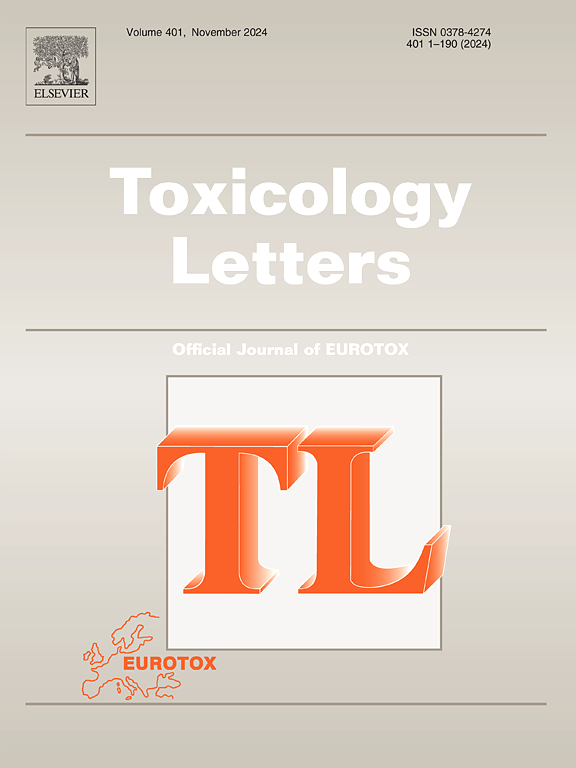自噬依赖性肝细胞凋亡介导吉特替尼诱导的肝毒性
IF 2.9
3区 医学
Q2 TOXICOLOGY
引用次数: 0
摘要
Gilteritinib是一种FLT3/AXL双重抑制剂,在临床上对复发/难治性FLT3突变的急性髓性白血病(AML)有效,但由于严重的肝毒性而受到限制。本研究探讨吉特替尼诱导肝损伤的分子机制,重点关注自噬和细胞凋亡之间的相互作用。体外和体内模型包括人肝细胞HL-7702细胞和C57BL/6 J小鼠。经western blot、TEM和mCherry-GFP-LC3报告基因检测证实,Gilteritinib治疗显著上调自噬标志物(LC3-II)并诱导自噬体形成。同时,凋亡标志物(裂解- parp、裂解- caspase3、Annexin V/PI染色)呈剂量和时间依赖性增加。自噬抑制剂3-甲基腺嘌呤(3-MA, 5 mM)或Atg7基因沉默对自噬的药理抑制可减轻细胞凋亡、线粒体膜电位损失和ROS过度产生,而Torin1(100 nM)诱导自噬则加重肝细胞死亡。在体内,gilteritinib处理的小鼠表现出血清谷丙转氨酶(ALT)、天冬氨酸转氨酶(AST)和乳酸脱氢酶(LDH)水平升高,并伴有组织病理学损伤,所有这些在atg7缺陷小鼠中都得到减轻。这些发现表明,吉特替尼会引发过度自噬,从而导致肝细胞凋亡和肝损伤。靶向自噬途径,代表了一种潜在的治疗策略,以减轻吉特替尼诱导的肝毒性,使这种重要的AML治疗更安全的临床应用。本研究阐明了药物性肝损伤中一个关键的自噬-凋亡轴,并为治疗靶向癌症治疗的不良反应提供了可行的见解。本文章由计算机程序翻译,如有差异,请以英文原文为准。
Autophagy-dependent hepatocyte apoptosis mediates gilteritinib-induced hepatotoxicity
Gilteritinib, a dual FLT3/AXL inhibitor, is clinically effective for relapsed/refractory FLT3-mutated acute myeloid leukemia (AML) but is limited by severe hepatotoxicity. This study investigates the molecular mechanisms underlying gilteritinib-induced liver injury, focusing on the interplay between autophagy and apoptosis. In vitro and in vivo models, including human hepatocyte HL-7702 cells and C57BL/6 J mice, were employed. Gilteritinib treatment significantly upregulated autophagy markers (LC3-II) and induced autophagosome formation, as confirmed by western blot, TEM, and mCherry-GFP-LC3 reporter assays. Concurrently, apoptosis markers (cleaved-PARP, cleaved-Caspase3, Annexin V/PI staining) increased dose- and time-dependently. Pharmacological inhibition of autophagy with autophagy inhibitor 3-methyladenine (3-MA, 5 mM) or gene silence of Atg7 attenuated apoptosis, mitochondrial membrane potential loss, and ROS overproduction, while autophagy induction by Torin1 (100 nM) exacerbated hepatocyte death. In vivo, gilteritinib-treated mice exhibited elevated serum alanine aminotransferase (ALT), aspartate aminotransferase (AST), and lactate dehydrogenase (LDH) levels, alongside histopathological damage, all of which were mitigated in Atg7-deficient mice. These findings demonstrate that gilteritinib triggers excessive autophagy, which drives hepatocyte apoptosis and liver injury. Targeting autophagy pathways, represents a potential therapeutic strategy to alleviate gilteritinib-induced hepatotoxicity, enabling safer clinical use of this vital AML therapy. This study elucidates a critical autophagy-apoptosis axis in drug-induced liver injury and provides actionable insights for managing adverse effects of targeted cancer therapies.
求助全文
通过发布文献求助,成功后即可免费获取论文全文。
去求助
来源期刊

Toxicology letters
医学-毒理学
CiteScore
7.10
自引率
2.90%
发文量
897
审稿时长
33 days
期刊介绍:
An international journal for the rapid publication of novel reports on a range of aspects of toxicology, especially mechanisms of toxicity.
 求助内容:
求助内容: 应助结果提醒方式:
应助结果提醒方式:


